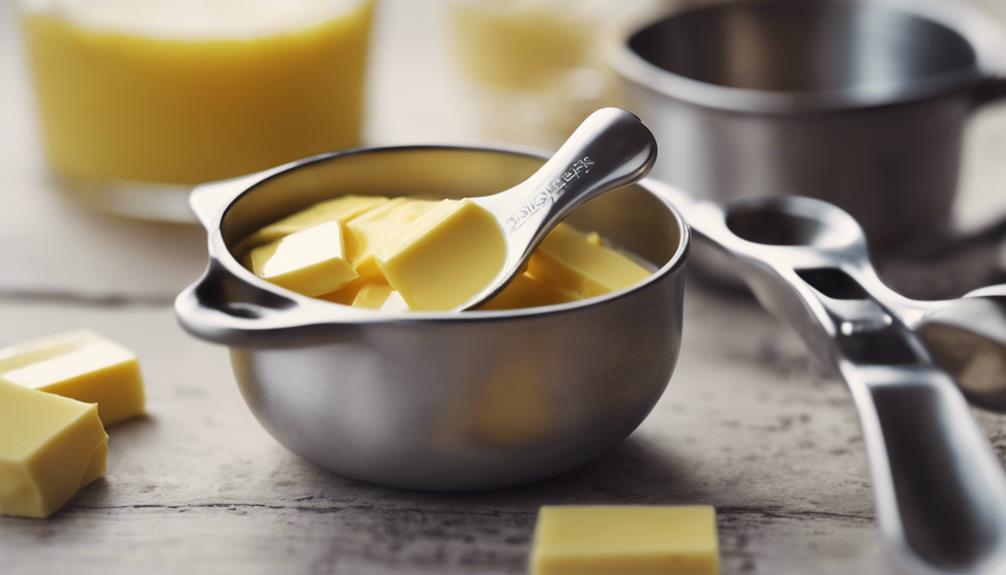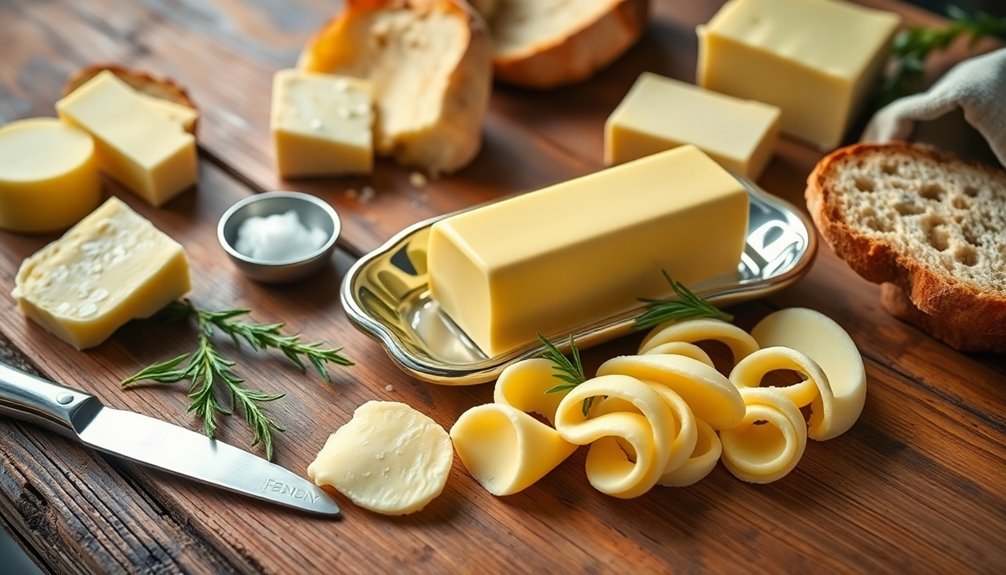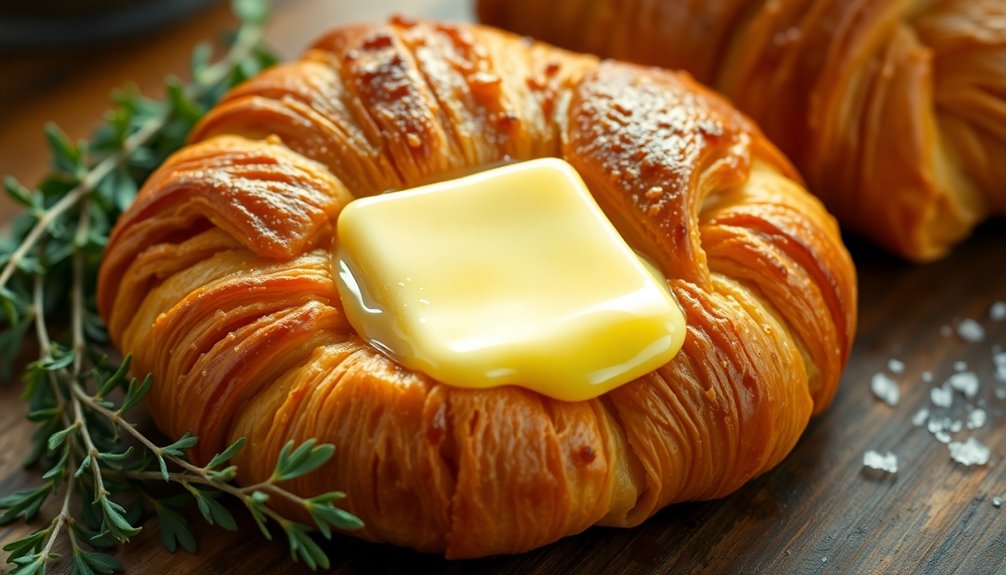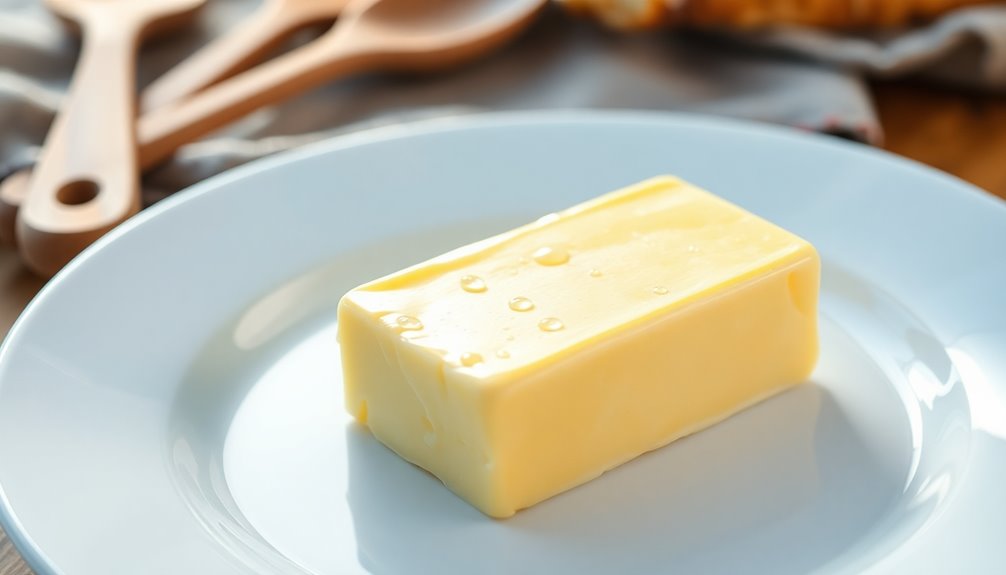Embrace French elegance with a French butter dish, an ideal way to keep your butter fresh and effortlessly spreadable. Start by softening your butter at room temperature and pressing it tightly into the lid's cavity, ensuring no air pockets. Fill the base with a small amount of cold water to create an airtight seal when you place the lid on. Check the water level every couple of days and add a pinch of salt to prevent mold. This tool not only preserves your butter but also adds a touch of sophistication to your table. Explore further for more tips on perfecting this technique.
Key Takeaways
- Press softened butter tightly into the lid cavity to eliminate air pockets.
- Fill the base with cold water until it touches the lid for an airtight seal.
- Add a pinch of salt to the water to prevent mold formation.
- Change the water every 2-3 days to maintain butter freshness.
- Ensure the lid fits snugly over the base to preserve butter's texture and flavor.
Understanding the French Butter Dish
The French Butter Dish, made up of a lid and base, keeps your butter fresh and spreadable. This ingenious tool, also known as a French butter keeper, originated in the 19th century and has since become a beloved kitchen staple.
By using water in its base, the dish creates an airtight seal around your butter, ensuring it stays fresh without refrigeration. This means you can keep your butter at room temperature, making it perfectly spreadable whenever you need it.
Imagine the convenience of having soft, easily spreadable butter ready for your morning toast or baking needs. No more struggling with hard, unyielding butter straight from the fridge. The French butter keeper makes this possible by protecting the fats in your butter from oxidizing, which can lead to unpleasant off flavors.
This preservation method enhances the taste and quality of your butter, making it a favorite among culinary enthusiasts, including the renowned Julia Child.
The Science Behind It

By understanding the principles of oxidation and airtight seals, you'll appreciate how the French Butter Dish maintains butter's freshness and flavor. The butter dish's design leverages water in the base to create an airtight seal around the butter, effectively preventing oxidation. This seal forms a protective barrier, which keeps the butter fresh and free from off flavors.
When butter is in contact with air, it can quickly become rancid due to oxidation. The French Butter Dish slows down this oxidation process to a considerable extent. The water in the base acts as a shield, ensuring the butter inside remains at its best quality for a week or longer. To further enhance its effectiveness, you can add a pinch of salt to the water to prevent mold formation, ensuring the butter stays fresh and safe to eat.
The French Butter Dish is also ideal for kitchens with varying temperatures. It effectively maintains the right texture and flavor of the butter, making it easier to spread.
Choosing the Right Size

When selecting a French butter dish, think about how much butter you typically use. A standard dish suits daily needs for one stick, while a larger one is perfect for family meals.
Matching the dish size to your habits guarantees you always have the right amount of butter on hand.
Ideal Butter Quantity
Choosing the appropriate size French Butter Dish guarantees you always have the perfect amount of butter on hand for your needs. Whether you're a solo diner or preparing breakfast for the whole family, the right dish ensures you've got just the right amount of butter inside.
Here's how you can choose the ideal size:
- Individual Use: A small French Butter Dish is perfect if you only need a modest amount of butter.
- Family Breakfasts: Opt for a larger dish that can hold more butter, making it easier to serve everyone.
- Standard Daily Use: Most regular dishes fit one stick of butter, which is excellent for everyday use.
- Special Occasions: A bigger dish is useful for holidays or gatherings when you need extra butter.
Consider your daily butter consumption and the number of people you're serving. A petite French Butter Dish is ideal for keeping just the right amount of butter inside for individual use, while a larger dish suits family settings.
Daily Usage Needs
Selecting the appropriate size French Butter Dish for your daily needs guarantees you always have the ideal amount of butter readily available. When choosing a French Butter Dish, consider how much butter you use daily. If you frequently enjoy buttered toast or use butter in your cooking, a standard-sized dish that fits one stick of butter may be perfect. This size allows you to keep your butter soft and spreadable without having to replenish constantly.
For smaller households or individuals, a petite dish might be more suitable. It provides just enough space to keep your butter fresh and easily accessible.
On the other hand, if you have a larger family or host frequent breakfast gatherings, a larger French Butter Dish can secure everyone has enough soft butter to go around.
The key to daily convenience lies in finding the right size that matches your butter consumption habits. The right dish won't only keep your butter at the perfect consistency but also make it easier to manage your kitchen routine. Proper sizing sets the foundation for a practical and enjoyable butter dish experience, guaranteeing you always have the right amount of French Butter at hand.
Family Vs. Individual
Choosing the right size French Butter Dish depends on whether you're catering to a family or just yourself. If your household consists of multiple butter lovers, a larger dish will be your best bet. However, if you're flying solo, a smaller dish tailored to individual butter needs will suffice.
Here are four key points to keep in mind:
- Household Size: A large family requires more butter, so a bigger dish ensures you won't constantly refill.
- Frequency of Use: Daily breakfast gatherings? Opt for a larger dish. Occasional use? A petite one does the trick.
- Storage Space: A smaller French Butter Dish takes up less room, perfect for compact kitchens.
- Serving Style: For elegant dinner parties, a larger dish offers generous portions, while a small one suits intimate meals.
Choosing the correct size sets the foundation for a seamless butter storage experience. A standard dish typically holds one stick of butter, ideal for daily use. Balancing the dish's capacity with your butter consumption habits is key to maximizing functionality. Whether you need a family-friendly size or one that caters to individual butter needs, the right French Butter Dish will enhance your dining experience.
Preparing Your Butter

To prepare your butter for the French Butter Dish, soften 1-2 sticks at room temperature until they're easy to spread. This step is vital because softened butter will pack more smoothly and evenly into the dish.
Once your butter is softened, take the lid of the French Butter Dish and get ready to pack it. Using a knife or your fingers, carefully place the softened butter into the lid. Make sure to press it tightly into the lid cavity, ensuring there are no air pockets.
The goal is to have the butter flush with the lip of the cup, creating a perfect seal when the lid is placed into the dish. This tight packing is essential for maintaining the freshness and spreadability of your French Butter.
Keep in mind that properly preparing your butter is the key to best usage of the French Butter Dish. By ensuring the butter is well-packed and flush with the lid, you're setting yourself up for a seamless and elegant butter experience. The butter in the lid will stay fresh and ready for use, allowing you to enjoy that touch of French elegance every time you spread it.
Filling the Water Reservoir
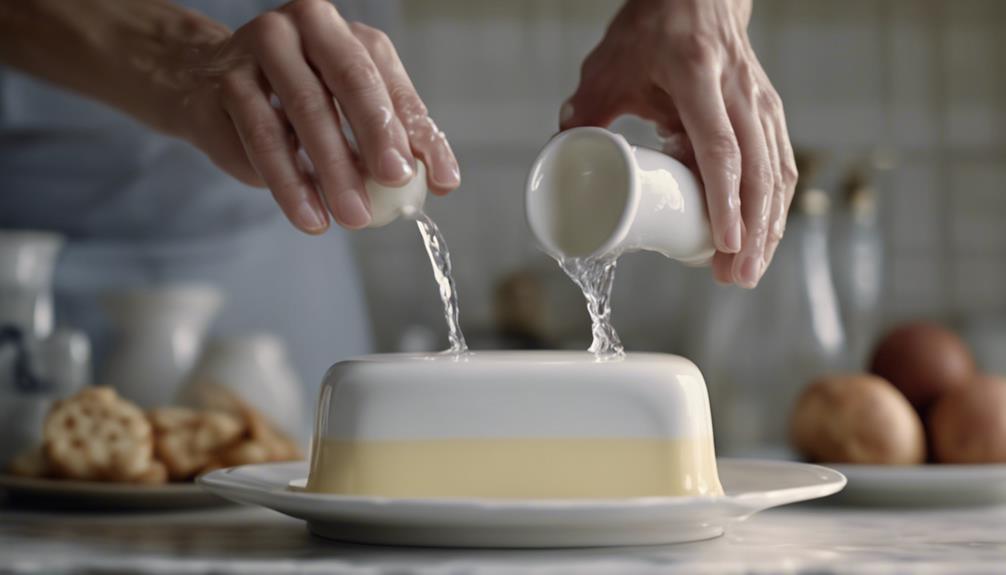
After packing the butter into the lid, it's time to fill the water reservoir to maintain its freshness. This step is important for creating an airtight seal that keeps your butter fresh and flavorful in the butter crock.
Here's how you can do it effectively:
- Clean the Base: Before you fill the base, make sure it's clean and dry. Any leftover residue can affect the quality of the water and, subsequently, the butter.
- Add Water: Pour a small amount of cold water into the base of the butter crock. Typically, 1/4 to 1/2 inch of water is sufficient.
- Check the Water Level: The water should be high enough to come into contact with the inverted lid but not overflow. This ensures the airtight seal is created.
- Regular Maintenance: Change the water every 2-3 days to maintain the best freshness and taste of your butter.
An effective water barrier is necessary because it protects the butter from air exposure, which can cause rancidity. By keeping the water fresh and at the right level, you maintain your butter in excellent condition.
Placing the Lid

When placing the lid on your French butter dish, make sure it fits snugly to create an effective seal.
This step is important for keeping the butter fresh and maintaining its texture.
A properly positioned lid will protect the butter from external elements, making sure it remains spreadable and flavorful.
Proper Lid Placement
Gently place the lid on the butter dish to ensure it creates an airtight seal. This step is essential for maintaining your butter fresh and protected from external elements. Proper lid placement is key to preserving the butter's best temperature and spreadable consistency.
An airtight seal not only preserves the butter's flavor and texture but also extends its shelf life.
To achieve the most favorable results, follow these steps:
- Ensure Clean Edges: Make sure the edges of both the lid and the dish are clean and free from butter residue. This helps the lid sit properly and create a tight seal.
- Align Correctly: Carefully align the lid with the dish so that it sits evenly. Misalignment can prevent the lid from sealing correctly.
- Press Gently But Firmly: Apply gentle yet firm pressure to the lid to ensure it fits snugly onto the dish.
- Check for Gaps: After placing the lid, check for any gaps that might allow air to enter. Adjust if necessary.
Sealing Butter Effectively
Placing the lid correctly on your French butter dish is vital for maintaining an airtight seal that keeps your butter fresh and flavorful. To achieve this, make sure the lid fits snugly over the dish. A proper seal not only preserves the butter's freshness but also keeps it spreadable and ready to use.
When you place the lid on the dish, ensure there are no gaps where air can seep in. This helps in maintaining the butter's texture and flavor by preventing external elements like dust, moisture, and odors from affecting its quality.
The airtight seal is essential because it acts as a barrier, protecting your butter from spoilage and maintaining its freshness longer. The lid's role in sealing the butter effectively can't be emphasized enough. By creating this airtight environment, you extend the butter's shelf life even when stored outside the fridge. This is particularly advantageous if you enjoy having soft, easily spreadable butter at room temperature.
Ensuring Freshness
To preserve your butter stays fresh and spreadable, place the lid securely on your French butter dish. The lid not only conserves the butter's flavor and texture but also creates an airtight seal that keeps external elements at bay.
Here's how you can make sure you're doing it right:
- Check the Fit: Make sure the lid fits snugly over the dish. Any gaps can compromise the airtight seal.
- Press Down Gently: Apply slight pressure when placing the lid to make certain it locks into place, creating an airtight environment.
- Regularly Inspect: Occasionally check for any cracks or wear in the lid that could impact the seal.
- Store Properly: Keep the French butter dish in a cool, dry place to maintain best freshness.
Storing Your Butter
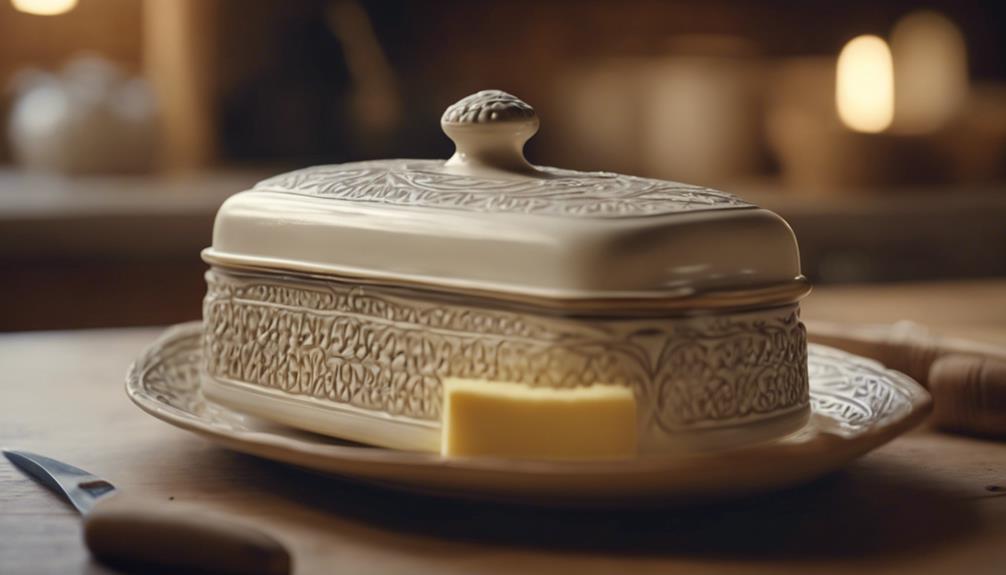
For best outcomes, pack softened butter tightly into the lid cavity of your French butter dish. This ensures the butter maintains its shape and is easy to spread. Once the lid is filled, place it into the base, making sure the water touches the butter to create an airtight seal. This seal keeps the butter fresh and spreadable at room temperature.
To further improve the freshness, consider adding a pinch of salt to the water. This simple step helps to prevent mold formation, especially if you live in a humid climate. Remember to refill the water in the base about once a week to guarantee the butter stays fresh.
In hot weather, you might want to refrigerate the French butter dish to sustain the butter's consistency. Otherwise, the butter may become too soft or even melt. Here's a quick reference table to help you:
| Task | Frequency | Tip |
|---|---|---|
| Pack softened butter | Every refill | Use a spatula to avoid air pockets |
| Refill water in base | Weekly | Add a pinch of salt to prevent mold |
| Refrigerate butter dish | During hot weather | Keeps the butter's consistency intact |
Maintaining Your Butter Dish

Maintaining your French butter dish is straightforward and maximizes your butter stays fresh and delicious. By following a few simple steps, you can optimize your butter stays at its best for longer periods.
First, always keep an eye on the water reservoir. This is essential for maintaining the airtight seal that keeps your butter fresh. Here are some key points to remember:
- Check the water level regularly – Ensure the water reservoir in the base is always filled. This helps create the airtight seal necessary for preserving the butter.
- Refill as needed – Refill the water every few days to keep the butter spreadable.
- Add a pinch of salt – To prevent mold formation, add a pinch of salt to the water.
- Clean periodically – Regular cleaning of your French butter dish keeps it in optimal condition and maximizes the freshness of your butter.
Enhancing Your Table Setting
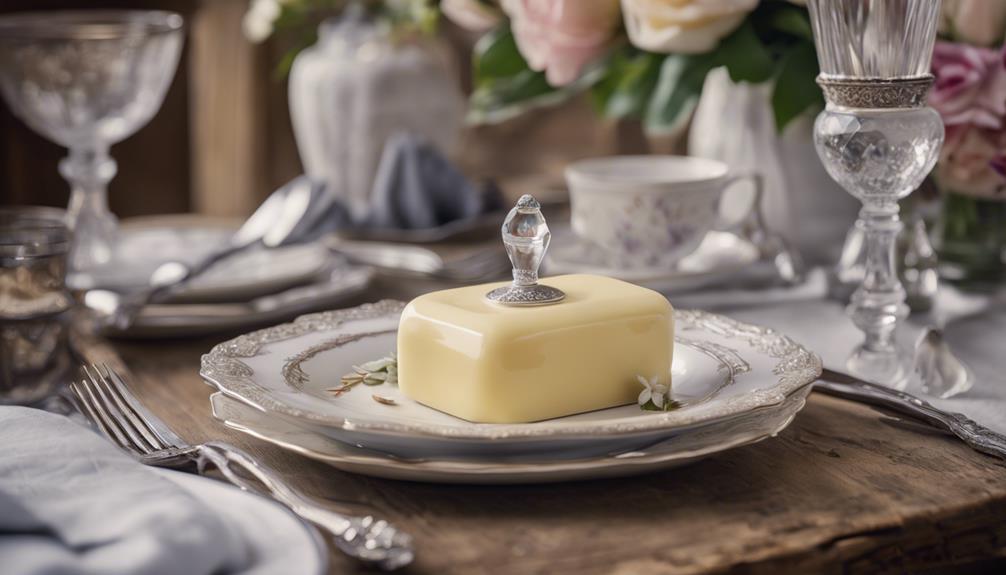
A French butter dish instantly elevates your table setting, infusing it with elegance and a touch of culinary tradition. When you incorporate this charming piece, you're not just adding functionality; you're making a statement. Typically crafted from porcelain, a French butter dish brings a refined, sophisticated element to your dining experience.
Imagine your guests' delight when they see a beautiful French butter dish at the center of your table setting. It's not just about the aesthetics; it's about the experience. The porcelain material not only looks stunning but also keeps your butter at the perfect spreadable consistency. This small yet significant detail can transform an ordinary meal into a memorable dining occasion.
Incorporating a French butter dish into your table setting adds a layer of authenticity and charm. It's a nod to French culinary traditions, showing that you appreciate the finer things in life. Whether you're hosting a casual brunch or an elegant dinner, this porcelain piece seamlessly fits any occasion, enhancing your overall table decor.
Frequently Asked Questions
How to Use a French Butter Dish?
To use a French butter dish, fill the lid with room temperature butter. Add water to the base for an airtight seal. Regularly refill the water and add salt to prevent mold. Enjoy fresh, spreadable butter daily.
What Is the Correct Way to Use a Butter Dish?
Using a butter dish is like giving your butter a cozy home. Pack softened butter into the lid cavity, fill the base with water, and seal it. Refill the water regularly and add salt to prevent mold.
Why Do You Put Water in a French Butter Dish?
You put water in a French butter dish to create an airtight seal that preserves freshness. This water barrier also regulates temperature, ensuring the butter stays spreadable. Adding salt to the water can prevent mold and extend freshness.
What Is the Benefit of the French Butter Dish?
The benefit of the French butter dish is that it keeps your butter fresh and spreadable at room temperature. You'll enjoy enhanced taste and texture, as it prevents oxidation and off flavors. Perfectly spreadable butter awaits!
Conclusion
You've set the scene with a French butter dish, but the magic is just beginning. Imagine the delight of spreading perfectly softened butter on your morning toast.
As you fill the water reservoir and place the lid, you're not just preserving butter; you're embracing elegance.
Now, the suspense builds—will you amaze your guests with this touch of French sophistication? Maintain it well, and your table setting will always have that je ne sais quoi.
Ready to impress?

